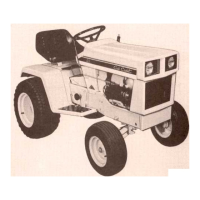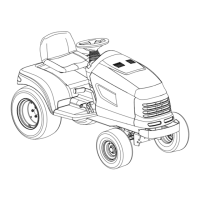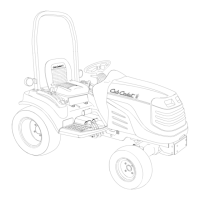ELECTRICAL SYSTEM
98
3. Top left middle square-shape: Yellow wire with
Black trace:
• Behavior: Should show DC power with the key
on.
• Circuitry: The yellow wire with black leads to
the PTO switch and the PTO relay. It allow the
RMC module to apply a ground to the coil of the
PTO relay, which energizes the relay, severing
the ground to the PTO clutch. When the PTO
relay energizes it also applies a ground to the
PTO switch. This ground loops back to the PTO
relay’s coil, latching it in the energized position.
• Interpretation: If behavior is correct, the N.C.
side of the PTO switch /circuit is functioning
properly
If there is continuity to ground, then there is a
short to ground either between the PTO relay
and the RMC module or in the PTO switch circuit.
4. Bottom left middle rounded-shape: Yellow wire
• Behavior: When the terminal is probed (yellow
wire), there should be continuity to ground only
when the seat
is empty.
• Circuitry: The yellow wire leads to the seat
safety switch, where it finds a path to ground
when the seat is empty.
• Interpretation: If behavior is correct, the seat
safety circuit is good. If there is continuity to
ground when the seat is occupied, the switch
may be inoperative, or there may be a short to
ground in the wire leading to it. If there is not
continuity to ground when the seat is empty, the
switch may be inoperative or there may be an
open condition in the wire leading to it.
5. Top right middle square-shape: There is a red
wire with black trace between yellow wire with a
black trace and the green wire. This wire pro-
vides the module with input from the reverse
switch.
• Behavior: When the tractor is in reverse, this
terminal should have continuity to ground.
• Circuitry: This wire runs directly to the reverse
safety switch.
• Interpretation: Continuity to ground when the
tractor is not in reverse would indicate a short to
ground. This could take the form of a chafed wire
contacting ground or a shorted reverse safety
switch.
Lack of continuity to ground would indicate:
• A broken or disconnected wire leading to
the reverse safety switch
• A switch that is not closing because of
physical damage or corrosion.
• Loss of ground to the reverse switch.
6. Top right rounded-shape: is a green wire
.
• Behavior: The green wire should always have
continuity to ground.
• Circuitry: The green wire leads to ground.
• Interpretation: If this ground path is not good,
there will probably be other ground-related
issues with the tractor: slow starter motor, slow
battery charge, dim lights. All ground connec-
tions should be mechanically secure and corro-
sion free.
7. Bottom left square-shape: The red wire
on the
OCR plug carries battery voltage.
• Behavior: With key switch in any of the run posi-
tions, D.C. battery voltage should show-up on a
volt meter when the red probe is touched to this
terminal and the black probe is grounded.
• Circuitry: This wire draws power from the A1
terminal on the key switch.
• Interpretation: If there is not battery voltage at
this terminal, the tractor is probably not function
at all. Look for a blown fuse or a bad key switch.
8. Bottom right middle rounded-shape: The purple
wire provides a ground signal to the RMC mod-
ule when the key switch is placed in the
REVERSE CAUTION MODE.
• Behavior: There should be continuity to ground
at this terminal when the key switch is in the
REVERSE CAUTION MODE position.
• Circuitry: When the key switch is in the
REVERSE CAUTION MODE position, a ground
path is established by connecting terminal A2 to
terminal L within the key switch. The purple wire
from the RMC module connects to A2, and a
green ground wire connects to L.
